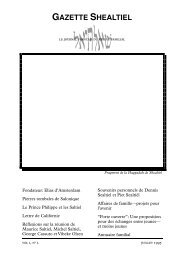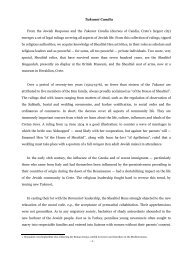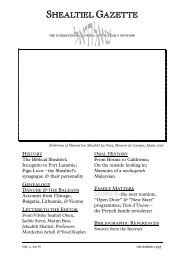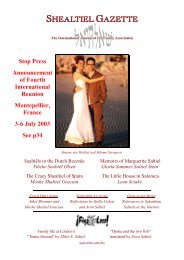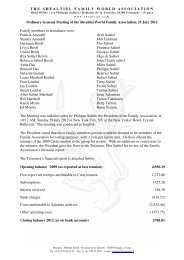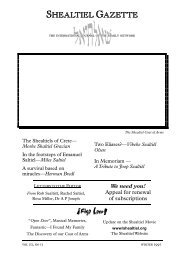a thesis by Flora Jane Satt - Shealtiel
a thesis by Flora Jane Satt - Shealtiel
a thesis by Flora Jane Satt - Shealtiel
Create successful ePaper yourself
Turn your PDF publications into a flip-book with our unique Google optimized e-Paper software.
<strong>Flora</strong> <strong>Jane</strong> <strong>Satt</strong>—annotated <strong>by</strong> Miles SaltielSaltiel was a Portuguese Jew from New York City who had come toColorado in 1867. By 1876 the Cotopaxi area had begun to attract afew settlers and many mining prospectors. Several shafts had beenopened and sluices put in operation at the site of Gold Tom’s firststrikes. Saltiel became interested in the Cotopaxi Lode, particularlywhen he learned that the discoverer, Henry Thomas, did nothave the capital or experience to work it. Saltiels’s business andpolitical contacts in Denver were well-know in Fremont Countyand his influence with officials of the Denver and Rio Grande Railroadwas sufficient to have that company designate his newlyacquiredproperty around Cotopaxi as a major stop on their run toSouth Arkansas (Salida), build there a large depot and call the stop“Saltiels”.Saltiel had filed on 2,000 acres of Government land and made tokenpayments at the county clerk’s office in Cañon City <strong>by</strong> 1878.This acreage was a long, narrow strip running north and southOak Grove Creek and Bernard Creek. Within his “property”, whichhe defined as a “town and land company” development, SaltielBiography of Emanuel SaltielSaltiel was not Portuguese but aSephardic Jew from England, born on16th October, 1844 (or 1845, documentsdiffer) at 30 James Street, Bath, a spatown in the west of the country. He wasnamed after his maternal grandfather,Emanuel Harris. His father’s occupationis given as shoemaker. He served as an“Officer of Cadets” in the Tenth TowerHamlets Riflemen. He then emigrated toNew Orleans and in the Civil Warmustered to the Confederacy. InSeptember 1864 he was a Lieutenant,acting as an aide de campe when he wastaken prisoner when Atlanta was taken <strong>by</strong>Sherman’s army. In prison camp, heassumed the identity of Joseph Isaacs toescape an outbreak of retaliatoryexecutions of Confederate officers and heenlisted under that name to serve as aprivate in the US Army on the westernfrontier. In boot camp he was promptlymade up to Sergeant.In May 1866 he was discharged from thearmy in Fort Laramie, Wyoming, afterbeing found guilty of “disloyalty” at akangaroo court martial. The recordimmediately following is confusing as theNew York Tribune announcement of hismarriage dated 23 rd November 1866 giveshis address as West 77 th Street, New YorkCity, though we know that at this time hewas writing for the local paper in Denver.In 1867 he joined with George Barnett topublish the Denver Daily Times, whichfolded after a few months. He and Barnettthen took their printing equipment to theWyoming territory where in February1868 they published the History andBusiness Directory of Cheyenne andGuide to the Mining Regions of the RockyMountains. The record shows that hespent the next fifteen years between theRocky Mountains and New York City.From 1870 to 1872 he is listed as aresident variously of 270 West 38 th Street,and 544 Broadway, both in New YorkCity. He reported the occupation of editorand (from a business address at 37 ParkAvenue) patent agent.At more or less this time, his nameappears in the record of the RockyMountain region as founder of the SaltielMica and Porcelain Company. Later in lifehe was the proprietor of the CotopaxiPlacer Mining Co. and the Colorado ZincCo. From 1883 to 1885, he was once againlisted as a resident of New York City witha home on Madison Avenue at East 126 thStreet and an establishment where helisted himself as a civil engineer at 50Exchange Street in the financial district.Also at this time, he brought his brother,Woolf, and his sister-in-law to be,Adelaide Ginsburg, to the United States.5They are the forbears inter alia of BobSaltiel of Lafayette, California and hisfamily. Woolf and Adelaide lived at 152Orchard Street. Saltiel married threetimes: first in 1866 to Elisabeth Woolf, hispre-war sweetheart from New Orleans.He and Elisabeth had three children, theforbears inter alia of the Tenants ofIndiana, Dewey Exxon of Vista,California, and Staff Sergeant WilliamSalter of Hermiston Oregon, currentlyserving his second tour of duty in Iraq.Saltiel and Elisabeth divorced circa 1881,Elisabeth turning up in New York the yearafter Saltiel left, that is 1886. On 14thFebruary 1883, he married FannyShelvelson. This mésalliance ended indivorce a year later, whereupon hemarried Annie Phelan who survived him.He had no children <strong>by</strong> his second or thirdmarriages.Saltiel ended his days in January 1900 atthe abandoned township of Seminoe,twenty miles north-east of Rawlins,Wyoming, where he had been promotingan integrated coal and iron works.Although his grave in Rawlins isunmarked, the record of his burialdenominates him as a Jew.As an addendum, this note serves also tocorrect Ida Libert Uchill’s erroneousidentification of Saltiel as South African.(Uchill, Op. cit., p175 in original).



